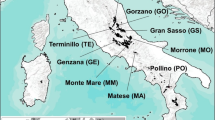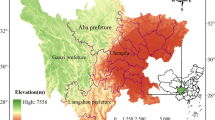Abstract
We analyzed forest clearing and regrowth over a 23-year time period for 21 forest concession and management units within the Maya Biosphere Reserve(MBR), Guatemala. The study area as a whole experienced a clearing rate of0.16%/year from 1974 through 1997. The overall clearing rate appears rather low when averaged over the entire study area over 23 years because most of the reserve was inaccessible. However, despite the granting of legal protection to the MBR in 1990, clearing rates continued to rise, with the highest rates occurring in the most recent time period in the analysis, 1995 to1997. Higher rates of clearing relative to regrowth occurred in newly established communities and in the Reserve's buffer zone, where the clearing of high forest was preferred for pasture development. Exploratory models were built and analyzed to examine the effects of various landscape variables on forest clearing. The different units in the analysis showed different relationships of forest clearing with variables such as forest cover type and distance to access(roads and river corridors). Where available, socio-economic household survey data helped to explain patterns and trends observed in the time series Landsat imagery. A strong relationship between forest clearing and distance to access was demonstrated. More clearing occurred further from roads during later time periods as farmers moved deeper into the forest to find land to clear. Communities inside the MBR that were less dependent on farming had forest clearing to regrowth ratios of one:one or less. These communities used fallow fields in greater proportions than communities in the Reserve's buffer zone. General trends in clearing by forest cover type suggest a preference for clearing high forest (bosque alto) types found on the higher elevation, better-drained soils, and fallow fields,and an avoidance of low-lying, seasonally flooded terrain(bajos). Satellite remote sensing observations of forest clearing and regrowth patterns can provide an objective source of information to complement socio-economic studies of the human driving forces in land cover and land use change.
Similar content being viewed by others
References
Cohen W.B., Fiorella M., Gray G., Helmer E. and Anderson K. 1998. An efficient and accurate method for mapping forest clearcuts in the Pacific Northwest using Landsat imagery. Photogrammetric Engineering and Remote Sensing 64: 293-300.
Congalton R.G. and Green K. 1999. Assessing the Accuracy of Remotely Sensed Data: Principles and Practices. CRC Press, Boca Raton, FL, USA, 137p.
Culbert T.P. 1993. Maya Civilization. Smithsonian Institution, Washington D.C., USA.
De Pietri 1995. The spatial configuration of vegetation as an indicator of landscape degradation due to livestock enterprises in Argentina. Journal of Applied Ecology 32: 857-865.
Eckhardt D.W., Verdin J.P. and Lyford G.R. 1990. Automated update of an irrigated lands GIS using SPOT HRV imagery. Photogrammetric Engineering and Remote Sensing 56: 1515-1522.
ERDAS 1997. ERDAS (v.8.3) Field Guide. 4th edn. ERDAS Inc., Atlanta, Georgia, USA.
ESRI 1998. ARC version 7.2.1. Environmental Systems Research Institute. Redlands, California, USA.
Fearnside P.M. 1986. Spatial concentration of deforestation in the Brazilian Amazon. Ambio 15: 74-81.
Fox J.J., Krummel S., Yarnasarn M., Ekasingh and Podger N. 1995. Land use and landscape dynamics in northern Thailand: Assessing change in three upland watersheds. Ambio 24: 328-334.
Frohn R.C., McGwire K.C., Dale V.H. and Estes J.E. 1996. Using satellite remote sensing to evaluate a socio-economic and ecological model of deforestation in Rhondônia, Brazil. International Journal of Remote Sensing 17: 3233-3255.
Hall et al. 1991. Radiometric rectification: toward a common radiometric response among multidate, multisensor images. Remote Sensing of Environment 35: 11-27.
Hayes D.J. and Sader S.A. 2001. Change detection techniques for monitoring forest clearing and regrowth in a tropical moist forest. Photogrammetric Engineering and Remote Sensing 67: 1067-1075 (in press).
Jensen J.R. 1996. Introductory Digital Image Processing. 2nd edn. Prentice-Hall, Upper Saddle River, NJ, USA, 316p.
Jensen J.R., Rutchey K., Koch M.S. and Narumalani S. 1995. Inland wetland change detection in the Everglades Water Conservation Area 2A using a time series of normalized remotely sensed data. Photogrammetric Engineering and Remote Sensing 61: 199-209.
Kimes D.S., Nelson R.F., Skole D.L. and Salas W.A. 1998. Accuracies in mapping secondary tropical forest age from sequential satellite imagery. Remote Sensing of Environment 65: 112-120.
Kristensen P.J., Gould K. and Thomsen J.B. 1997. Approaches to field-based monitoring and evaluation implemented by Conservation International. In: Proceedings and Papers of the InternationalWorkshop on Biodiversity Monitoring. Brazilian Institute for Environment and Renewable Resources, Pirenopolis, Brazil, pp. 129-144.
Lambin E.F. 1994. Modelling Deforestation Processes: A Review. Tropical Ecosystem Environment Observations by Satellites (TREES) Research Report No.1. European Commission, Luxembourg.
Liu D., Iverson L.R. and Brown S. 1993. Rates and patterns of deforestation in the Philippines: application of geographic information system analysis. Forest Ecology and Management 57: 1-16.
Meyer W.B. and Turner B.L. II 1994. Changes in Land Use and Land Cover: A Global Perspective. University of Cambridge, University press, Cambridge, UK, 537p.
Nations J.D., Primack R.B. and Bray D. 1998. Introduction: the Maya Forest. In: Primack R.B., Galleti H.A., Bray D. and Ponciano I. (eds), Timber Tourists and Temples. Island Press, Washington D.C., USA.
Rice D.S. 1991. Roots. Natural History 1991: 10-14.
Rindfuss R.R. and Stern P.C. 1998. Linking remote sensing and social science: the needs and challenges. In: People and Pixels, Linking Remote Sensing and Social Science. National Academy Press, Washington D.C., pp. 1-27.
Running S.W., Peterson P.L., Spanner M.A. and Teubler K.B. 1986. Remote sensing of coniferous leaf area. Ecology 67: 273-276.
Sader S.A. and Joyce A.T. 1988. Deforestation rates and trends in Costa Rica, 1940-1983. Biotropica 20: 11-19.
Sader S.A., Stone T.A. and Joyce A.T. 1990. Remote sensing of tropical forests: an overview of research and applications using non-photographic sensors. Photogrammetric Engineering and Remote Sensing 56: 1343-1351.
Sader S.A., Sever T.L., Smoot J.C. and Richards M. 1994. Forest change estimates for the northern Petén region of Guatemala. Human Ecology 22: 317-322.
Sader S.A. 1995. Spatial characteristics of forest clearing and regrowth as detected by Landsat Thematic Mapper Imagery. Photogrammetric Engineering and Remote Sensing 61: 1145-1151.
Sader S.A., Reining C., Sever T. and Soza C. 1997. Human migration and agricultural expansion: a threat to the Maya tropical forests. Journal of Forestry 1997: 27-32.
Sader S.A., Hayes D.J., Coan M., Hepinstall J.A. and Soza C. 2001. Forest change monitoring of a remote biosphere reserve. International Journal of Remote Sensing 22: 1937-1950.
Schwartz N.B. 1990. Forest Society. University of Pennsylvania Press, Philadelphia, PA, USA.
Schwartz N.B. 1998. Time series changes in land use: social science report, phase 1. Submitted to University of Maine, Orono, MA, USA, NASA LCLUC Program, Contract NAG5-6041.
Sellers P.J. 1985. Canopy reflectance, photosynthesis, and transpiration. International Journal of Remote Sensing 6: 1335-1372.
Sever T.L. 1998. Validating prehistoric and current social phenomena upon the landscape of the Petén, Guatemala. In: People and Pixels, Linking Remote Sensing and Social Science. National Academy Press, Washington D.C., USA.
Singh A. 1986. Change detection in the tropical forest environment of northeastern India using Landsat, Remote Sensing and Tropical Land Management. John Wiley and Sons, New York, NY, USA, 365p.
Skole D. and Tucker C. 1993. Tropical deforestation and habitat fragmentation in the Amazon: satellite data from 1978 to 1988. Science 260: 1905-1910.
Tucker C.J. 1979. Red and photographic infrared linear combinations for monitoring Vegetation. Remote Sensing of the Environment 8: 127-150.
Turner M.G. and Gardner R.H. (eds) 1991. Quantitative Methods in Landscape Ecology. Springer-Verlag, New York, NY, USA, 536p.
Turner M.G. 1990. Spatial and temporal analysis of landscape patterns. Landscape Ecology 4: 21-30.
Turner B.L. II, Meyer W.B. and Skole D.L. 1994. Global land-use/land-cover change: towards an integrated study. Ambio 23: 91-95.
Author information
Authors and Affiliations
Rights and permissions
About this article
Cite this article
Hayes, D.J., Sader, S.A. & Schwartz, N.B. Analyzing a forest conversion history database to explore the spatial and temporal characteristics of land cover change in Guatemala's Maya Biosphere Reserve. Landscape Ecology 17, 299–314 (2002). https://doi.org/10.1023/A:1020542327607
Issue Date:
DOI: https://doi.org/10.1023/A:1020542327607




